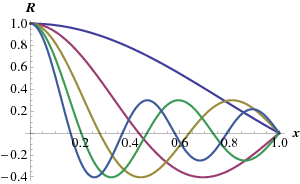10.7: Our Initial Problem and Bessel Functions
- Page ID
- 8327
We started the discussion from the problem of the temperature on a circular disk, solved in polar coordinates, Since the initial conditions do not depend on \(\phi\), we expect the solution to be radially symmetric as well, \(u(\rho,t)\), which satisfies the equation
\[\begin{aligned} \frac{\partial u}{\partial t} &= k\left[ \frac{\partial^2 u}{\partial \rho^2} + \frac{1}{\rho} \frac{\partial u}{\partial \rho} \right],\nonumber\\ u(c,t) &=0,\nonumber\\ u(\rho,0) &= f(\rho).\end{aligned} \nonumber \]
With \(u(\rho,t)=R(\rho)T(t)\) we found the equations
\[\begin{aligned} \rho^2 R''+\rho R' + \lambda \rho^2 R &= 0\;\;\;\;R(c)=0\nonumber\\ T'+\lambda k T = 0.\end{aligned} \nonumber \]
The equation for \(R\) is clearly self-adjoint, it can be written as
\[[\rho R']' + \lambda \rho R = 0 \nonumber \]
So how does the equation for \(R\) relate to Bessel’s equation? Let us make the change of variables \(x= \sqrt{\lambda} \rho\). We find
\[\frac{d}{d\rho} = \sqrt{\lambda} \frac{d}{dx}, \nonumber \]
and we can remove a common factor \(\sqrt{\lambda}\) to obtain (\(X(x)=R(\rho)\))
\[[x X']' + x X = 0, \nonumber \]
which is Bessel’s equation of order \(0\), i.e.,
\[R(\rho) = J_0(\rho \sqrt{\lambda}). \nonumber \]
The boundary condition \(R(c)=0\) shows that \[c \sqrt{\lambda_n} = x_n, \nonumber \]
where \(x_n\) are the points where \(J_0(x)=0\). We thus conclude \[R_n(\rho) = J_0(\rho \sqrt{\lambda_n}). \nonumber \] the first five solutions \(R_n\) (for \(c=1\)) are shown in Fig. \(\PageIndex{1}\).

From Sturm-Liouville theory we conclude that
\[\int_0^\infty \rho d\rho \,R_n(\rho)R_m(\rho)=0\;\;{\rm if\ }n \neq m. \nonumber \]
Together with the solution for the \(T\) equation,
\[T_n(t)= \exp(-\lambda_n k t) \nonumber \]
we find a Fourier-Bessel series type solution
\[u(\rho,t) = \sum_{n=1}^\infty A_n J_0(\rho\sqrt{\lambda_n})\exp(-\lambda_n k t), \nonumber \]
with \(\lambda_n= (x_n/c)^2\).
In order to understand how to determine the coefficients \(A_n\) from the initial condition \(u(\rho,0)=f(\rho)\) we need to study Fourier-Bessel series in a little more detail.


